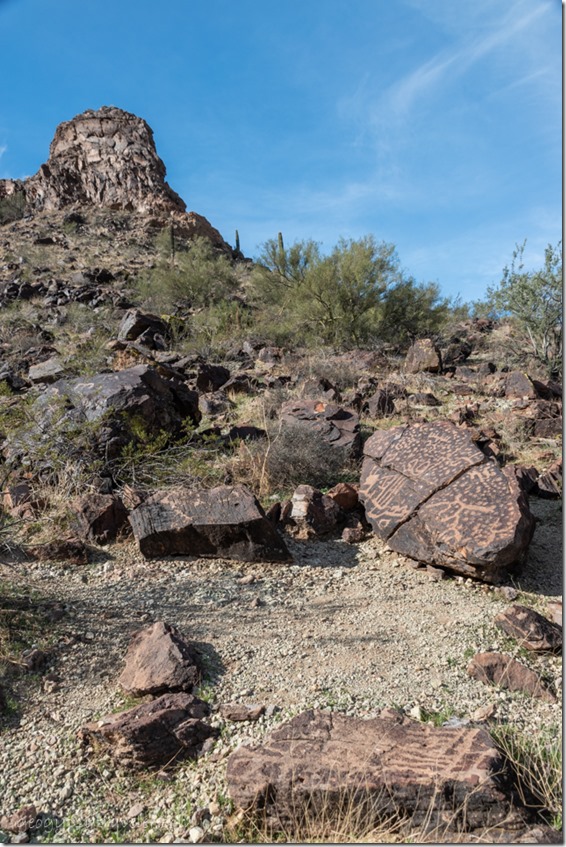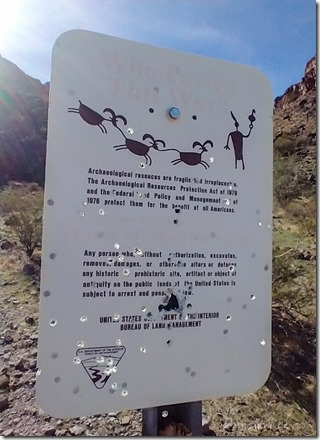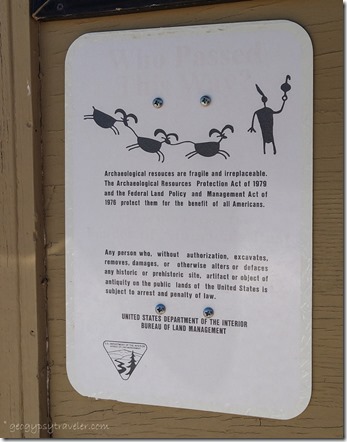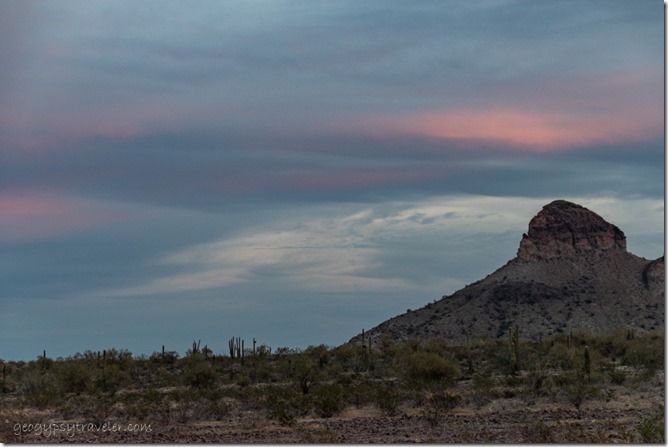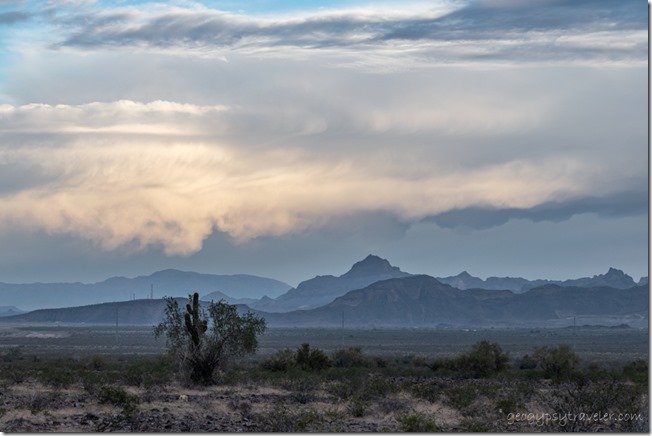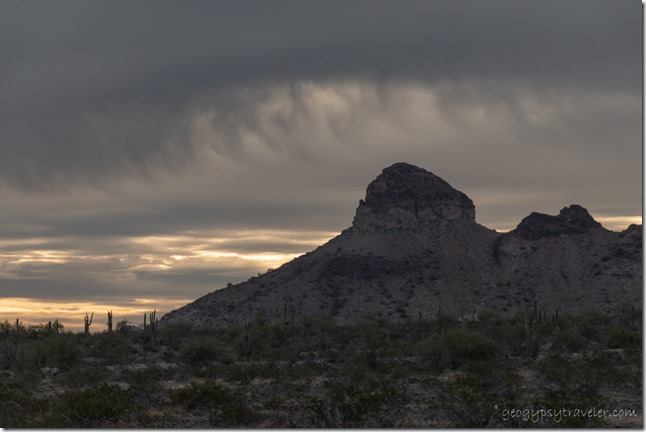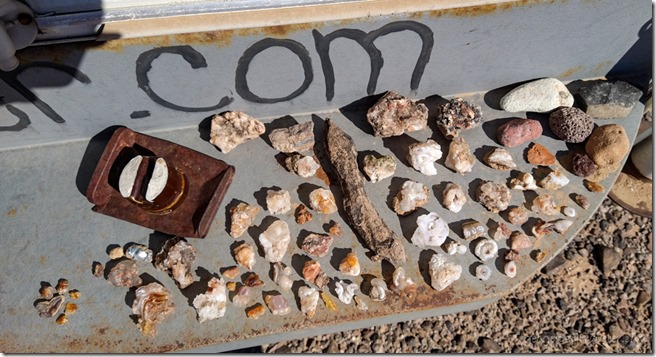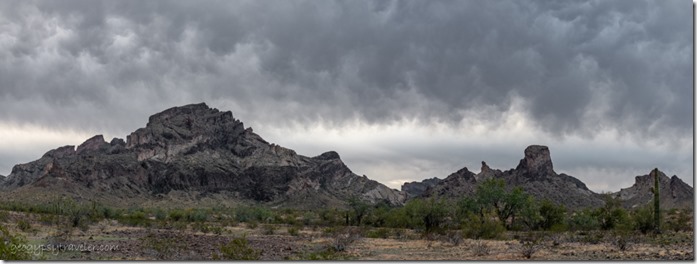 Saddle Mountain petroglyphs are noted in many places yet with limited information and no really clear trail. Maybe that’s for the best. I believe the area is better known for gathering chalcedony and fire agate.
Saddle Mountain petroglyphs are noted in many places yet with limited information and no really clear trail. Maybe that’s for the best. I believe the area is better known for gathering chalcedony and fire agate.
 We were headed to the base of the peak far left, I don’t know where they were going
We were headed to the base of the peak far left, I don’t know where they were going
Joann had walked from camp to the parking area but didn’t see any petroglyphs. Instead she returned with pockets full of pretty rocks. You can’t walk anywhere around here without something white, brown, or flashy on the ground to catch the eye. A couple days later, Joann drove us to the parking area where there was a mess from the weekend’s campers who I had heard shooting at something.
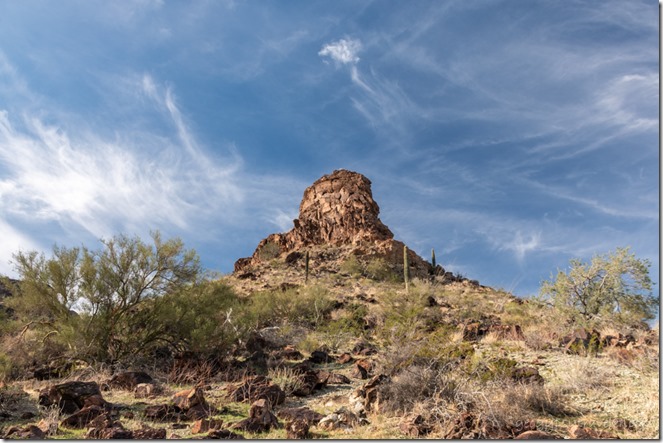 They’d also left beer can cairns that I presumed marked a trail to the Saddle Mountain petroglyphs. I started a short climb on what appeared to be an animal trail weaving across the slope. I had seen a friend’s photos of a large slab of rock covered with petroglyphs so swung my head back and forth looking down. Have to look down anyway just to walk because of all the rock trippers.
They’d also left beer can cairns that I presumed marked a trail to the Saddle Mountain petroglyphs. I started a short climb on what appeared to be an animal trail weaving across the slope. I had seen a friend’s photos of a large slab of rock covered with petroglyphs so swung my head back and forth looking down. Have to look down anyway just to walk because of all the rock trippers.
 These petroglyphs might have been created on cliff faces but now lay broken on the alluvial fan below the peak. We didn’t climb very high before going downwards towards another trail only a little more distinct and there it lay. Joann spotted the first, and largest seen, 8×3 foot slab covered with petroglyphs. What they mean, is pretty much anyone’s guess. I interpreted at least three Mt Sheep (upper right and bottom middle)—they do live in the area even though we haven’t seen them—and what I think looks like a map (left) that could represent the three major washes that drain into the Palo Verde foothills and valley below.
These petroglyphs might have been created on cliff faces but now lay broken on the alluvial fan below the peak. We didn’t climb very high before going downwards towards another trail only a little more distinct and there it lay. Joann spotted the first, and largest seen, 8×3 foot slab covered with petroglyphs. What they mean, is pretty much anyone’s guess. I interpreted at least three Mt Sheep (upper right and bottom middle)—they do live in the area even though we haven’t seen them—and what I think looks like a map (left) that could represent the three major washes that drain into the Palo Verde foothills and valley below.
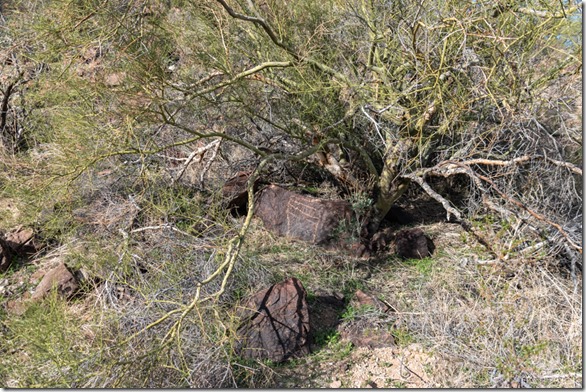 There were more petroglyphs on smaller pieces of nearby rock and as we followed the trail saw a few more here and there along the hillside. Neither of us climbed further up the scree. What goes up fairly easily with a walking stick can slide down much quicker with a fall.
There were more petroglyphs on smaller pieces of nearby rock and as we followed the trail saw a few more here and there along the hillside. Neither of us climbed further up the scree. What goes up fairly easily with a walking stick can slide down much quicker with a fall.
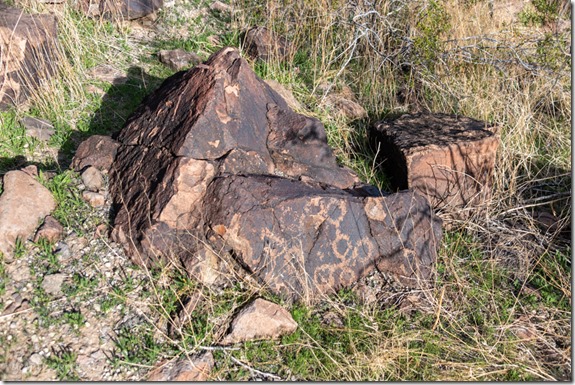 Imagine sitting who knows how long, slowly pecking away the dark outer layer of rock, manganese stain called desert varnish, to reveal the lighter color creating the story you wished to tell. I didn’t have much luck finding information online about who might have left these stories behind.
Imagine sitting who knows how long, slowly pecking away the dark outer layer of rock, manganese stain called desert varnish, to reveal the lighter color creating the story you wished to tell. I didn’t have much luck finding information online about who might have left these stories behind.
On left by the parking, on right by the road
Later, I conferred with a friend who is studying petroglyphs in the Southwest and he was unfamiliar with the Saddle Mountain petroglyphs site. Yet after looking at the photos of the petroglyphs we agreed on the Archaic Period (7500-2100 BCE-Before Common Era). This was a time of major adaptation for North American people as the climate warmed at the end of the last Ice Age. As mammoths and large animals like horses and camels began to disappear hunting for smaller animals caused a change in the size and shape of projectile points (arrowheads). Small game nets were woven from plant materials like the Yucca. A semi-nomadic lifestyle also followed the prime time to harvest native plants like cactus fruits, mesquite beans, acorns, and pine nuts. Corn from Mexico was planted near water sources and returned to for harvesting. Metates/grinding stones were used to make paste or flour from seeds and nuts. Probably pre-ceramics, instead weaving baskets from plant materials easily replaced and light weight. Archaic or Desert Cultures represent the longest span of human occupation in Arizona. These people lived in small bands, had an intimate knowledge of the plants and animals around them, and moved seasonally. Others followed, up to the most recent Anglo Americans. Like the pigs we cleaned up after, beer cans, bullets and shot gun shells.
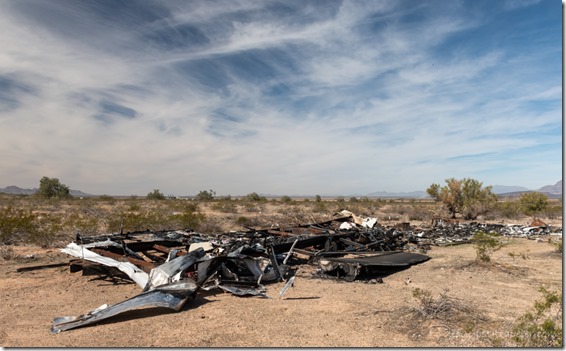 On the road back to pavement we saw the remains of an obviously burned trailer with frame and stuff everywhere. Must have been relatively recent as there’s even books and paper strewn nearby. I won’t even burn candles for fear of starting a fire in my RV. They burn so quickly, you don’t have time to kiss your ass goodbye.
On the road back to pavement we saw the remains of an obviously burned trailer with frame and stuff everywhere. Must have been relatively recent as there’s even books and paper strewn nearby. I won’t even burn candles for fear of starting a fire in my RV. They burn so quickly, you don’t have time to kiss your ass goodbye.
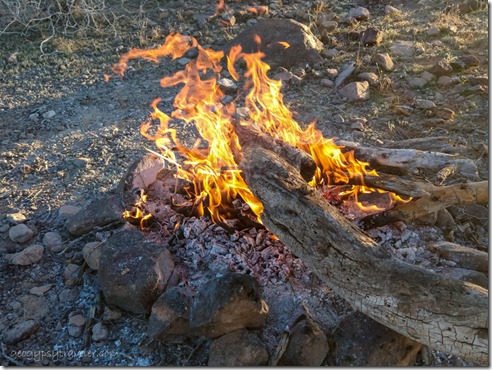 That night we had a campfire under a pretty sunset and shared stories. The next several nights, and days, were far too windy for fires. Even with clouds the camper battery stays charged by solar. Now to figure out why the 12v socket doesn’t always produce power. It’s always something.
That night we had a campfire under a pretty sunset and shared stories. The next several nights, and days, were far too windy for fires. Even with clouds the camper battery stays charged by solar. Now to figure out why the 12v socket doesn’t always produce power. It’s always something.
Discovered the downside of Saddle Mountain, wind from the north, or even not much wind, brought flies. Lots of flies from the nearby chicken ranch. One morning we could even smell chicken shit. Makes me glad to have a screen door but still have to be fast going in and out. And even then, have a fly swatter ready.
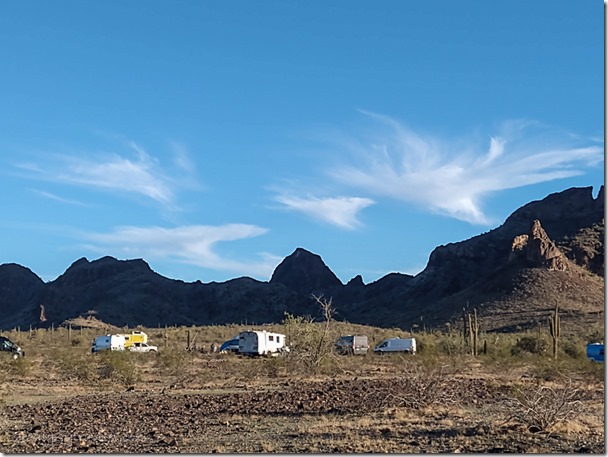 A home-made yellow truckcamper arrived and set up a respectable distance away. Then a van pulled in, followed by a skoolie, and another van, and another van. I was thinking, oh no, not another van-life gathering like at Kofa. Yet this was only about ten total over a couple days and pretty quiet except for some evening music around the campfire.
A home-made yellow truckcamper arrived and set up a respectable distance away. Then a van pulled in, followed by a skoolie, and another van, and another van. I was thinking, oh no, not another van-life gathering like at Kofa. Yet this was only about ten total over a couple days and pretty quiet except for some evening music around the campfire.
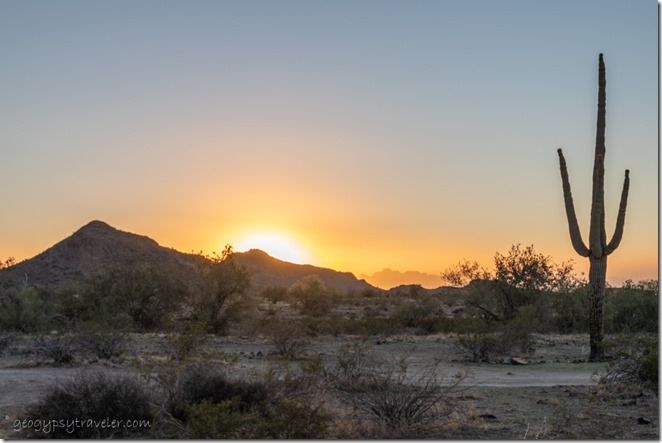 Brutal wind blew the clouds and flies away making the sunny and comfortable 60° rather intolerable to be outside. Not sure I could have gotten the door open anyway. Even inside the rocking got old. I’m good with my laptop and phone charged, two forms of entertainment other than reading a good book. In fact, I just finished reading a Robert Heinlein, To Sail Beyond the Sunset, that got missed in the early 2000s.
Brutal wind blew the clouds and flies away making the sunny and comfortable 60° rather intolerable to be outside. Not sure I could have gotten the door open anyway. Even inside the rocking got old. I’m good with my laptop and phone charged, two forms of entertainment other than reading a good book. In fact, I just finished reading a Robert Heinlein, To Sail Beyond the Sunset, that got missed in the early 2000s.
 Of course when the skies clear the overnight temperature drops to what I call chilly and by morning, downright cold at 34-38°. I know, that’s nothing compared to many of you living in northern, eastern, and even southeastern states these days. I’m sorry. Us Arizonans do tend to rub it in a bit when our winter highs reach anything over 60°, otherwise we’re wearing down jackets. Maybe I shouldn’t tell you that this week is predicted for high 70s. Sigh…..
Of course when the skies clear the overnight temperature drops to what I call chilly and by morning, downright cold at 34-38°. I know, that’s nothing compared to many of you living in northern, eastern, and even southeastern states these days. I’m sorry. Us Arizonans do tend to rub it in a bit when our winter highs reach anything over 60°, otherwise we’re wearing down jackets. Maybe I shouldn’t tell you that this week is predicted for high 70s. Sigh…..
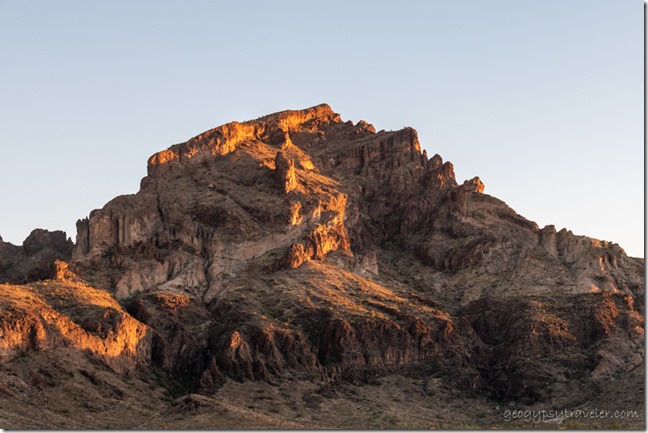 I’m not the only living thing slowed by cool/cold temperatures. Don’t see much wildlife other than a couple Ravens once in a while. One night at the campfire an owl silently flew over and landed briefly in our nearby Saguaro before swooping off for its next meal. While out gathering firewood under a warm afternoon sun, motion caught my eye as two ground squirrels chased each other from creosote bush to bush. Pausing to stand briefly, belly faced to the sun’s warmth, before disappearing back into one of the many burrow holes. The ground must be warming and waking up life in the desert.
I’m not the only living thing slowed by cool/cold temperatures. Don’t see much wildlife other than a couple Ravens once in a while. One night at the campfire an owl silently flew over and landed briefly in our nearby Saguaro before swooping off for its next meal. While out gathering firewood under a warm afternoon sun, motion caught my eye as two ground squirrels chased each other from creosote bush to bush. Pausing to stand briefly, belly faced to the sun’s warmth, before disappearing back into one of the many burrow holes. The ground must be warming and waking up life in the desert.
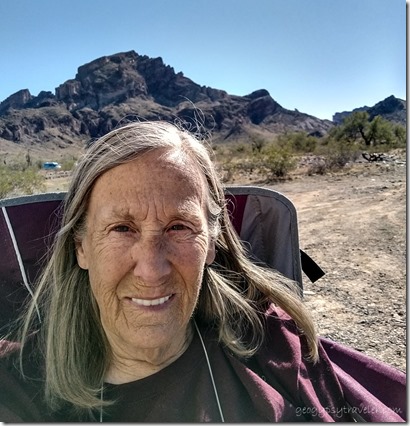 With temperatures rising, Joann headed a little further north. Not me. I’m not ready to give up the desert apricity. But the flies chased me from Saddle Mountain. Plus it was time to get some groceries and fill up propane. So off to Quartzsite. Mostly, I’m starting to think about a full moon rise over the Kofa Mountains.
With temperatures rising, Joann headed a little further north. Not me. I’m not ready to give up the desert apricity. But the flies chased me from Saddle Mountain. Plus it was time to get some groceries and fill up propane. So off to Quartzsite. Mostly, I’m starting to think about a full moon rise over the Kofa Mountains.
Note: I do not call petroglyphs or pictographs rock art. A wise native man once said to me, “These marks on the rock are not art. My people have art. These are stories.” Sadly, some of the stories have been lost to time.

